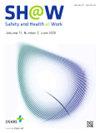利用机器学习预测肩部肌肉骨骼疾病的工作相关性
IF 2.9
3区 医学
Q1 PUBLIC, ENVIRONMENTAL & OCCUPATIONAL HEALTH
引用次数: 0
摘要
本研究旨在通过机器学习算法建立肩部疾病的工作相关性预测模型。该数据集包括7270例8,302人,申请职业病并获得韩国工人补偿和福利院疾病评估委员会的最终批准决定,与肩部肌肉骨骼疾病相关,时间为2020年1月至2021年12月。在本研究中,进行了人口统计学分析和肩部疾病的批准率的差异。此外,利用逻辑回归、支持向量机、决策树、随机森林和XGBoost等机器学习算法构建工作相关性评估的预测模型。结果对各模型的性能进行了评价。XGBoost的准确率为81.64%,曲线下面积为0.73,random forest的准确率为84.46%,曲线下面积为0.73。影响工作相关性评价的主要因素有就业期、身体负担评分、性别和年龄。结论各种机器学习技术的应用表现出较高的绩效分数,表明机器学习技术有助于减少职业环境医学医师之间的判断差异。本文章由计算机程序翻译,如有差异,请以英文原文为准。
Prediction of Work-relatedness of Shoulder Musculoskeletal Disorders as by Using Machine Learning
Background
This study aimed to develop prediction models for the work-relatedness of shoulder diseases through machine learning algorithms.
Methods
The dataset comprised 7,270 cases of 8,302 individuals who applied for occupational diseases and received the final approval decision from the Korea Workers' Compensation and Welfare Service's Disease Evaluation Committee, which is related to shoulder musculoskeletal disorders between January 2020 and December 2021. In this study, demographic analysis and difference of approval rate by shoulder diseases were performed. Additionally, machine learning algorithms, including logistic regression, support vector machine, decision tree, random forest, and the XGBoost, were utilized to construct prediction models for work-relatedness assessment.
Results
The performance of each model was evaluated. XGBoost showed an accuracy of 81.64% and an area under the curve of 0.73, and random forest showed an accuracy of 84.46% and an area under the curve of 0.73. Key factors influencing work-relatedness assessment were employment period, physical burden score, gender, and age.
Conclusion
The application of various machine learning techniques showed high performance score, representing that it would be helpful to reduce the differences in judgment between occupational environment medicine physicians.
求助全文
通过发布文献求助,成功后即可免费获取论文全文。
去求助
来源期刊

Safety and Health at Work
Social Sciences-Safety Research
CiteScore
6.40
自引率
5.70%
发文量
1080
审稿时长
38 days
期刊介绍:
Safety and Health at Work (SH@W) is an international, peer-reviewed, interdisciplinary journal published quarterly in English beginning in 2010. The journal is aimed at providing grounds for the exchange of ideas and data developed through research experience in the broad field of occupational health and safety. Articles may deal with scientific research to improve workers'' health and safety by eliminating occupational accidents and diseases, pursuing a better working life, and creating a safe and comfortable working environment. The journal focuses primarily on original articles across the whole scope of occupational health and safety, but also welcomes up-to-date review papers and short communications and commentaries on urgent issues and case studies on unique epidemiological survey, methods of accident investigation, and analysis. High priority will be given to articles on occupational epidemiology, medicine, hygiene, toxicology, nursing and health services, work safety, ergonomics, work organization, engineering of safety (mechanical, electrical, chemical, and construction), safety management and policy, and studies related to economic evaluation and its social policy and organizational aspects. Its abbreviated title is Saf Health Work.
 求助内容:
求助内容: 应助结果提醒方式:
应助结果提醒方式:


